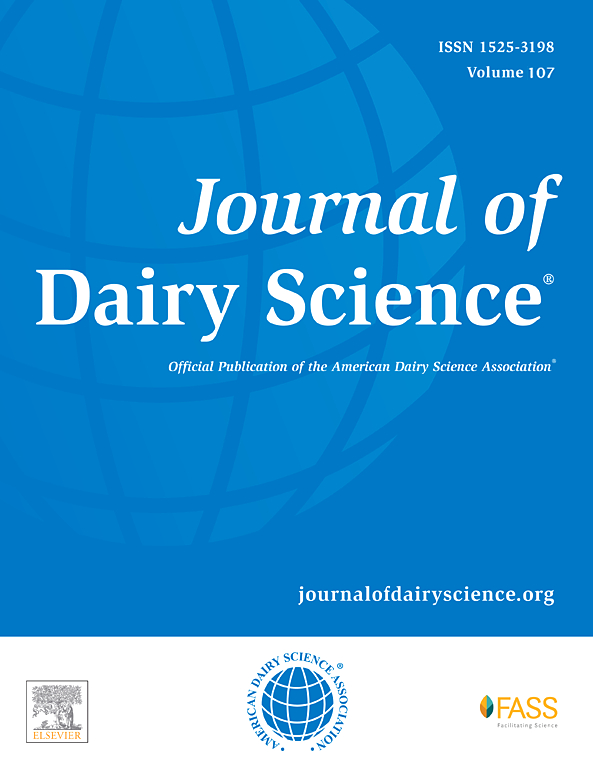Associations between days open and dry period length versus milk production, replacement, and fertility in the subsequent lactation in Holstein dairy cows
IF 3.7
1区 农林科学
Q1 AGRICULTURE, DAIRY & ANIMAL SCIENCE
引用次数: 0
Abstract
A retrospective, observational approach was used to investigate the association between days open and dry period length in one lactation, and survivability, production, and reproductive performance in the subsequent lactation. Animal-level data from 60 intensively managed, year-round-calving US Holstein herds were collected. A subset of this larger dataset was identified that also had recorded genomic test results including Dairy Wellness Profit Index (DWP$). Data from 109,374 cows comprised the larger dataset (AllCows), and 37,680 cows comprised the genomics subset (GenCows). Average days open of the previous lactation (PDOPN) was 114 d, and the average dry period length (PDDRY) before the lactation of interest was 58. Response outcomes had a standard endpoint of 90 DIM of the subsequent lactation and included proportion replaced, cumulative milk production (CUM90), and proportion pregnant. Proportion replaced and proportion pregnant were analyzed using multivariable logistic regression. Milk production was analyzed using a linear mixed model. Continuous explanatory variables included previous lactation 305-d ME milk (P305ME), wk-36 milk (WM36), PDOPN, PDDRY, and DWP$ (GenCows only). Categorical variables included previous lactation parity group (PLCTGP 1, 2, or 3+), calf type (female, male, or twins), and number of clinical mastitis (NMAST) or clinical lameness (NLAME) events recorded in the previous lactation. Both diseases were classified based on the number of cases recorded (0, 1, or 2+ cases). Important 2-way interactions were also considered. Increases in PDOPN were associated with increased odds of replacement, whereas the effect of PDDRY varied in a curvilinear manner, with shortest and longest PDDRY associated with highest odds of replacement. Odds of replacement increased with each increase in PLCTGP and with higher levels of recorded mastitis or lameness. Calf type was significant; delivery of twins was associated with a higher risk of replacement than a male calf. A female calf had the lowest risk of replacement than either male calf or twins. Higher P305ME was associated with lower odds of replacement. Increasing values of DWP$ were associated with reduced odds of replacement. Higher P305ME was associated with greater CUM90. Both NMAST and twins were associated with reduced CUM90. Higher DWP$ was associated with greater CUM90. The lowest PDOPN and PDDRY were associated with the highest risk of pregnancy, but the magnitude of the negative effect of PDOPN increased as PLCTGP increased. Increasing levels of P305ME had a small negative statistical association with risk of pregnancy, which is biologically insignificant. Twins, NMAST, and NLAME each had large negative effects on the odds of pregnancy by 90 DIM. Meanwhile, increases in DWP$ were associated with increased odds of achieving pregnancy. Despite significant differences between parity groups, the overall conclusion is that cows should be managed to conceive earlier rather than later in lactation and then experience a traditional dry period length to improve the likelihood of high subsequent lactation performance and high reproductive performance, and to reduce the risk of premature replacement.
荷斯坦奶牛开产天数和干奶期长度与下一泌乳期产奶量、替代率和繁殖力之间的关系。
本文章由计算机程序翻译,如有差异,请以英文原文为准。
求助全文
约1分钟内获得全文
求助全文
来源期刊

Journal of Dairy Science
农林科学-奶制品与动物科学
CiteScore
7.90
自引率
17.10%
发文量
784
审稿时长
4.2 months
期刊介绍:
The official journal of the American Dairy Science Association®, Journal of Dairy Science® (JDS) is the leading peer-reviewed general dairy research journal in the world. JDS readers represent education, industry, and government agencies in more than 70 countries with interests in biochemistry, breeding, economics, engineering, environment, food science, genetics, microbiology, nutrition, pathology, physiology, processing, public health, quality assurance, and sanitation.
 求助内容:
求助内容: 应助结果提醒方式:
应助结果提醒方式:


